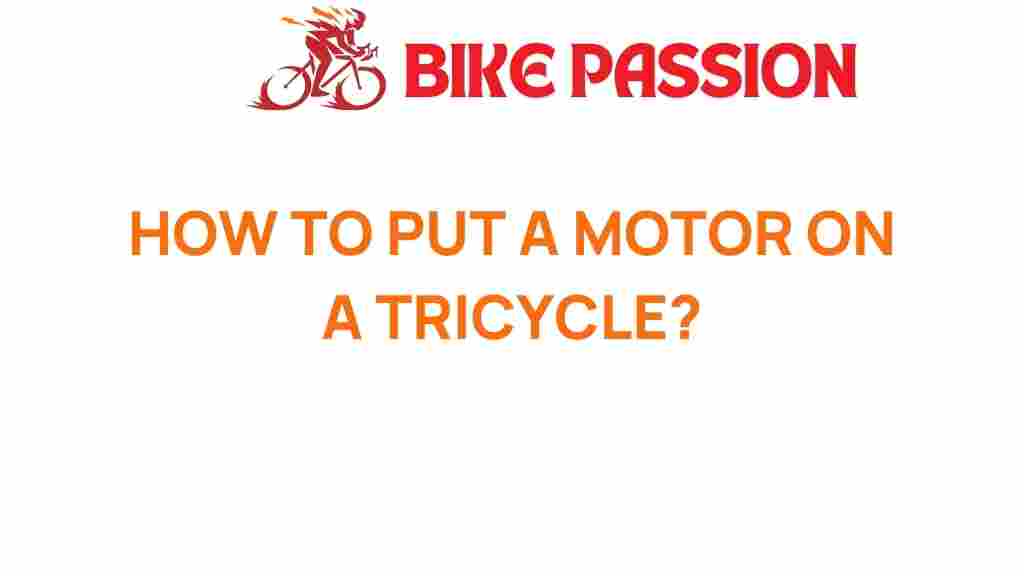Unleashing Speed: How to Transform a Tricycle with a Motor
Are you looking to add a touch of thrill and speed to your cycling experience? Transforming a standard tricycle into a motorized bike can be an exciting DIY project that not only enhances your cycling experience but also offers a fantastic way to innovate your ride. In this article, we will explore how to convert a traditional tricycle into a speedy electric tricycle, delving into essential tips, step-by-step guidance, and troubleshooting methods. Get ready to unleash speed with your custom tricycle!
Understanding the Basics of Tricycle Motors
Before diving into the transformation process, it’s crucial to understand what a tricycle motor entails. A tricycle motor typically refers to an electric or gas-powered motor that can be attached to a tricycle to provide propulsion. This conversion allows for a significant speed enhancement, making your rides more enjoyable, especially over long distances.
Benefits of Motorizing Your Tricycle
- Speed Enhancement: A motorized bike can reach speeds that are hard to achieve with pedaling alone.
- Less Physical Strain: Ideal for those who may have difficulty pedaling for extended periods.
- Fun Factor: Adding a motor can make cycling more exciting and enjoyable.
- Eco-Friendly Option: Electric tricycles produce no emissions, making them a sustainable choice.
Step-by-Step Guide to DIY Tricycle Conversion
Now that you understand the benefits, let’s dive into the step-by-step process of transforming your tricycle into a motorized bike.
Step 1: Gather Your Materials
For this project, you’ll need the following materials:
- Tricycle (preferably a sturdy model)
- Tricycle motor kit (electric or gas)
- Battery (for electric motors)
- Controller
- Throttle
- Wiring and connectors
- Basic tools (wrenches, screwdrivers, etc.)
- Safety gear (gloves, goggles)
Step 2: Choosing the Right Motor
When selecting a motor for your custom tricycle, consider the following factors:
- Power: The motor’s wattage will determine how fast your tricycle can go. A motor between 500W to 1500W is usually ideal for speed enhancement.
- Type: Decide whether you want an electric motor for a quieter ride or a gas engine for more power.
- Compatibility: Ensure the motor kit is compatible with your tricycle model.
Step 3: Installing the Motor
Follow these steps to install the tricycle motor:
- Prepare the Tricycle: Clean the tricycle and remove any unnecessary components that may hinder the installation.
- Attach the Motor: Secure the motor to the rear axle or the frame of the tricycle, depending on your motor type. Make sure it’s firmly attached to avoid any movement during riding.
- Install the Battery: If using an electric motor, mount the battery securely on the frame, ensuring it’s easily accessible for charging.
- Connect the Controller: Follow the manufacturer’s instructions to connect the controller to the motor and battery.
- Install the Throttle: Attach the throttle to the handlebars for easy access while riding.
Step 4: Wiring and Safety Checks
Wiring is a critical component of your motorized bike. Ensure all connections are secure and insulated to prevent short circuits. Double-check the following:
- All wires are correctly connected according to the instructions.
- The battery is charged and functioning properly.
- Safety features, such as fuses, are in place.
Step 5: Testing Your Motorized Tricycle
Before taking your new electric tricycle for a spin, conduct a thorough test:
- Check the throttle response while stationary.
- Ensure the brakes are functioning properly.
- Test the motor by slowly accelerating in an open area.
Troubleshooting Tips
After you’ve completed your DIY tricycle project, you may encounter some common issues. Here are some troubleshooting tips:
- Motor Not Starting: Check the battery charge and wiring connections.
- Insufficient Speed: Ensure the motor is powerful enough and that the gearing is appropriate for speed enhancement.
- Overheating: Make sure the motor is not overloaded and is getting adequate ventilation.
Maintaining Your Motorized Tricycle
To keep your electric tricycle running smoothly, regular maintenance is essential:
- Check the battery life and connections regularly.
- Inspect the motor for any wear and tear.
- Keep the tricycle clean to prevent rust and damage.
Conclusion: Embrace Cycling Innovation
Transforming a standard tricycle into a motorized bike can be a rewarding DIY home project. By following the steps outlined in this article, you can unleash speed and innovation in your cycling experience. Whether you opt for an electric tricycle or a gas-powered motor, the key is to choose the right components and ensure a safe installation. Remember, cycling innovation is all about enhancing your journey while enjoying the process of creation!
For more information on cycling innovations, check out this resource for additional tips and ideas.
Ready to take on your DIY tricycle project? Gather your materials and get started on your path to a custom tricycle that meets your speed needs!
This article is in the category Gear and created by BikePassion Team
